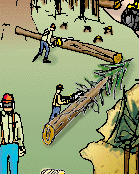Logging eTool
Manual Operations » Limbing and Bucking

Limbing is cutting branches off of felled or standing trees. Bucking is sawing felled trees into sections called logs. The length of the logs is dependent on the species of the tree and type of final product.
- Primary hazards include unstable logs, and hazards associated with using chain saws.
- Examples of proper bucking to relieve tension for top bind and bottom bind are provided below.
As a tree falls it will often brush other trees and leaves broken live limbs or dead limbs hanging in surrounding trees. Sometimes falling trees will shoot off the stump and roll sideways or ahead creating pressures on tree limbs. Loggers should never limb a tree immediately after felling. It is often a good idea to drop several trees and then refuel the saw prior to limbing. This will provide more time for overhead hazards to come down.
Prior to limbing, loggers should evaluate five potential hazards as follows:
- Overhead hazards
- Spring poles
- Butt movement forward (creates back pressure on limbs).
- Butt twist (creates sideways pressure on limbs).
- Butt off the ground (creates tension and compression on the tree stem).
Highlights of Limbing and Bucking Requirements
- Limbing and Bucking must be done on the uphill side of each tree or log, where rolling or sliding of logs may be expected.
- Precautions, such as moving to a stable position, must be taken to prevent the logs or the butt from striking employees while limbing and bucking trees.
Top Bind

Arrows indicate saw travel direction and cross-hatching indicates the heartwood that will break. Depending upon the soundness of the wood and the timber lie, it may be advantageous to use the end of the bar and bore from point (C) in making cuts number (1) and number (3) if it appears there could be a danger of the log slabbing.
NOTE: A wedge section could be removed when sawing cut (2) if the top bind is excessive, to allow the tree cut to close as cuts (4) and (5) are made.
Bottom Bind

Cuts are similar to those for top bind, except top and bottom cuts are reversed.
![]() Additional Information:
Additional Information:
- 29 CFR 1910 Subpart R, Special industries. OSHA Standard.
-
1910.266(h)(3), Limbing and bucking
-
- Logging. OSHA Preamble to Final Rules, (1994).
- Logging Operations. OSHA Federal Register Final Rules 60:47022-47037 (September 8, 1995). Amends the logging operations standard. [See Paragraph (h)(3)(i) -- Limbing and Bucking.]
- Logging Operations, Inspection Procedures and Interpretive Guidance Including Twelve Previously Stayed Provisions. OSHA Directive CPL 02-01-022 [CPL 2-1.22], (September 27, 1996). [See Definitions and clarifications: Paragraph (h) Tree Harvesting -- Paragraph (h)(3)(i) - Bucking and limbing.]

